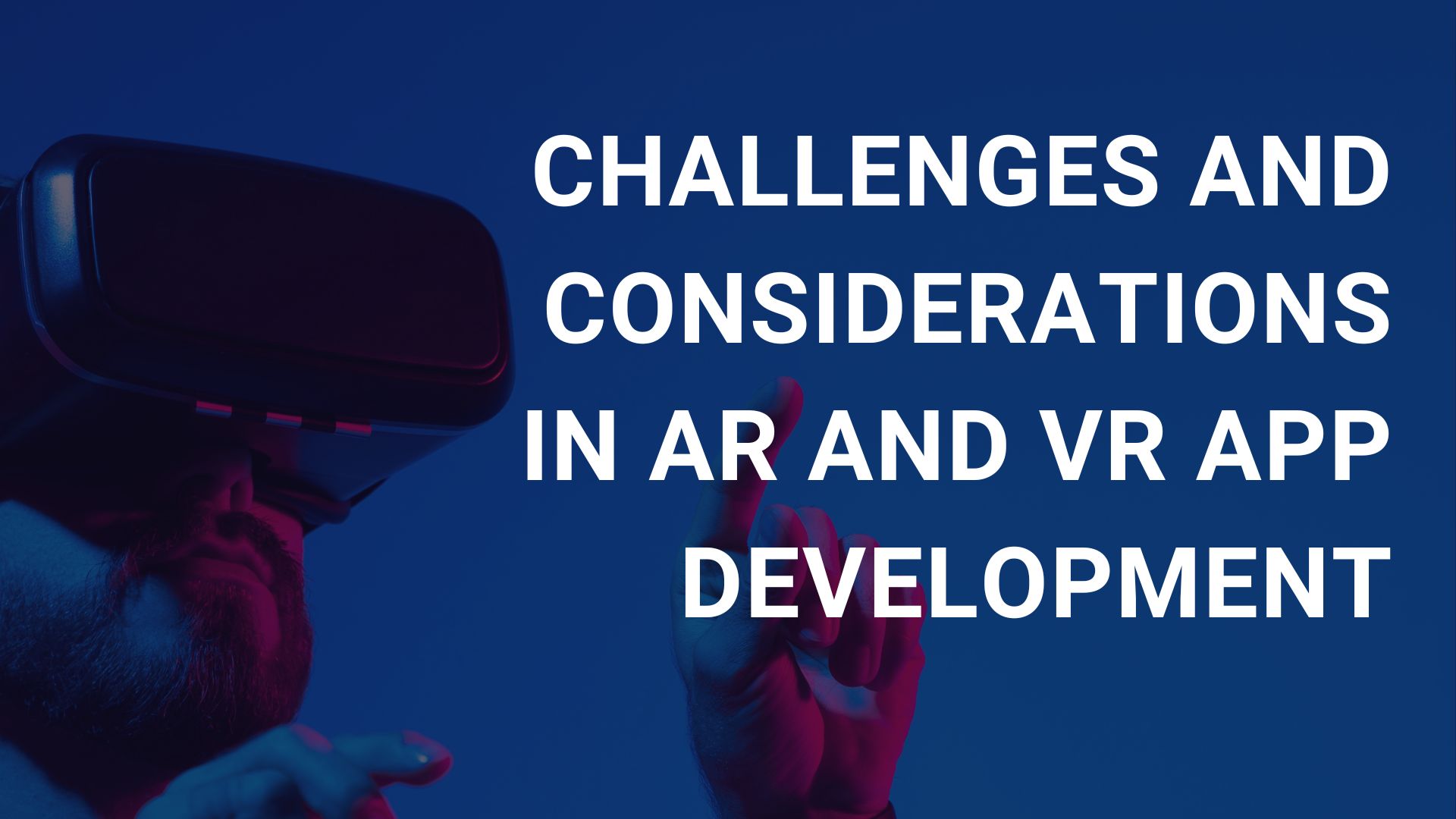
Emerging technologies have revolutionized the way people interact with each other and the world around them. Among these, Augmented Reality (AR) and Virtual Reality (VR) have gained significant popularity in recent years due to the unique experiences they offer. Mobile app development companies have a significant role to play in creating an immersive AR/VR experience that can captivate users and keep them engaged for hours. In this article, we will explore the various aspects of AR/VR technologies and understand how mobile app development companies can leverage them to provide an unparalleled user experience.
Augmented Reality (AR) and Virtual Reality (VR) are two different technologies that use computer-generated content to create an immersive experience. They have become increasingly popular in recent years, and their applications are limitless. Let’s take a closer look at each of them and explore their differences.
The concept of VR has been around since the 1960s, but it was only in the last decade that it became mainstream. The advancements in technology have made VR more accessible and affordable, and it is now being used in various industries, including gaming, education, and healthcare. VR uses a headset that creates an artificial environment that simulates a real-world scenario. The user can interact with this environment, and their actions get reflected on the screen.
AR, on the other hand, is a technology that combines the real world with digital content. It overlays digital content on top of real-world objects using a smartphone camera. Users don’t require any special equipment to experience AR, and it has become increasingly popular in recent years.
The primary differences between AR and VR are in the way they create a user experience. VR creates a completely artificial environment, while AR adds digital elements to the real world. VR is more immersive, and the user is fully immersed in the virtual world, while AR allows users to interact with digital objects in the real world. Both technologies have their advantages and disadvantages, and the choice of which one to use depends on the application and the user’s preferences.
The potential uses of AR and VR are limitless, and they are significantly impacting various industries. The healthcare sector is using AR/VR to create advanced training simulations that allow medical professionals to practice complex procedures in a safe and controlled environment. The education sector is using these technologies to create interactive learning environments that make learning more engaging and fun. Students can explore historical sites, visit museums, and travel to different parts of the world without leaving the classroom.
The gaming industry has been the primary benefactor of VR technology, with games like Beat Saber, Half-Life: Alyx, and Resident Evil 7 showcasing the potential of VR gaming. AR is being used by companies like Ikea to create an interactive shopping experience that allows customers to visualize how furniture will look in their homes before making a purchase. Other industries, such as architecture, engineering, and construction, are using AR/VR to create 3D models of buildings and structures, allowing architects and engineers to visualize their designs in real-time.
In conclusion, AR and VR are two exciting technologies that are transforming the way we interact with the world around us. They have the potential to revolutionize various industries and create new opportunities for businesses and individuals alike. As technology continues to advance, we can expect to see more innovative uses of AR and VR in the future.

Mobile app development has revolutionized the way we interact with technology. With the advent of AR and VR technologies, mobile app development companies are at the forefront of creating innovative and immersive experiences. AR and VR technologies have the potential to transform a wide range of industries, from healthcare and education to entertainment and retail. Here are some ways in which mobile app development companies are using AR/VR technologies:
Developing Customized AR and VR Solutions
Mobile app development companies can create customized AR/VR solutions based on client requirements. Whether it’s creating an interactive training module or an immersive gaming experience, mobile app development companies have the expertise to create unique solutions that cater to specific needs. For example, a healthcare app can use AR to create a virtual anatomy lab where medical students can practice surgical procedures in a safe and controlled environment. Similarly, a real estate app can use VR to create virtual property tours that allow potential buyers to explore properties from the comfort of their own homes.
Integrating AR and VR into Existing Mobile Apps
Mobile app development companies can integrate AR/VR into existing apps to take user engagement to the next level. Integrating AR/VR can make the app more interactive and allow users to see and interact with products in a more engaging way. For example, a retail app can use AR to allow customers to try out clothes virtually before making a purchase. This not only enhances the user experience but also increases the likelihood of making a sale. Similarly, a travel app can use VR to create virtual travel experiences that allow users to explore new destinations before booking a trip.
Ensuring a Seamless User Experience
Creating an immersive AR/VR experience requires careful planning and execution. Mobile app development companies are responsible for ensuring that users have a seamless experience while using the app. They need to optimize the app’s performance, create an intuitive interface, and ensure that the app is compatible with a variety of devices. For example, an AR/VR app that runs smoothly on an iPhone may not work as well on an Android device. Mobile app development companies need to take into account the different hardware and software specifications of various devices to ensure that the app works seamlessly across all platforms.
In conclusion, mobile app development companies play a crucial role in the development and implementation of AR and VR technologies. With their expertise and experience, they can create customized solutions, integrate AR/VR into existing apps, and ensure a seamless user experience. As AR and VR technologies continue to evolve, mobile app development companies will play an increasingly important role in shaping the future of these technologies.
Creating a captivating AR/VR experience requires careful planning and execution. Here are some tips on how to create an immersive experience:
Designing Engaging AR and VR Content
The success of a mobile app depends on the content it offers. When creating AR/VR content, it is essential to focus on creating engaging and interactive content that keeps the user engaged. The content should align with the app’s objective and be tailored to the user’s experience.
For example, if you’re creating an AR/VR experience for a museum, you could create an interactive exhibit that takes the user on a journey through time. The exhibit could include 3D models of artifacts and animations that bring them to life. Users could interact with the artifacts by zooming in and rotating them to see them from different angles. This would create an engaging and educational experience that would keep users coming back for more.
Leveraging 3D Models and Animations
AR/VR allows users to interact with digital objects in a realistic way. By leveraging 3D models and animations, mobile app development companies can create an immersive experience that feels like the user is interacting with real-world objects.
For example, if you’re creating an AR/VR experience for a real estate company, you could create a virtual tour of a property. The tour could include 3D models of the property, allowing users to explore it in detail. Animations could be used to show how different parts of the property are connected, giving users a better understanding of the layout. This would create an immersive experience that would help potential buyers get a better sense of the property before they visit it in person.
Implementing Interactive Features and Gamification
The success of games like Pokemon Go and Minecraft shows that gamification can significantly increase user engagement. Mobile app development companies can implement interactive features and gamification to take the user experience to the next level.
For example, if you’re creating an AR/VR experience for a fitness app, you could create a gamified workout that challenges users to complete different exercises. Users could earn points for completing exercises correctly and progress through different levels as they improve. This would create an engaging and motivating experience that would keep users coming back for more.
In conclusion, creating an immersive AR/VR experience requires careful planning and execution. By designing engaging content, leveraging 3D models and animations, and implementing interactive features and gamification, mobile app development companies can create experiences that keep users engaged and coming back for more.

Developing AR/VR apps can be a challenging and complex process. From hardware limitations to user privacy concerns, there are many critical considerations that mobile app development companies must keep in mind. Here are some of the challenges and considerations that developers face when creating AR/VR apps:
Hardware and Software Limitations
One of the most significant challenges in AR/VR app development is the hardware and software limitations. AR/VR technology requires powerful hardware to work correctly, and not all devices are compatible with this technology. Therefore, mobile app development companies must consider the hardware limitations when developing AR/VR apps. They need to ensure that the app works seamlessly across a variety of devices, including low-end devices.
Moreover, AR/VR app developers must consider the software limitations as well. They must ensure that their apps are compatible with different operating systems and versions, as well as different types of hardware configurations.
Balancing Performance and User Experience
Another critical consideration in AR/VR app development is balancing performance and user experience. AR/VR apps require powerful hardware to deliver an optimal user experience. However, the app’s performance must be optimized to ensure that it performs well even on low-end devices. Striking a balance between performance and user experience is crucial in AR/VR app development.
Developers must also consider the user experience when designing AR/VR apps. The app’s interface must be intuitive and easy to use. The app’s design must be optimized for the AR/VR environment, and it must provide an immersive experience for the user.
Ensuring User Privacy and Security
AR/VR apps collect a significant amount of user data, including location data, device information, and user behavior. Therefore, mobile app development companies must ensure that their apps follow all data privacy regulations and are secure.
Developers must implement robust security measures to protect user data from cyber threats. They must also ensure that the app’s data collection practices are transparent and that users have control over their data. Additionally, developers must obtain user consent before collecting any data.
In conclusion, developing AR/VR apps comes with its own set of challenges and considerations. Mobile app development companies must consider hardware and software limitations, balance performance and user experience, and ensure user privacy and security to create successful AR/VR apps.
AR/VR technology has the potential to revolutionize the way we interact with the world around us. Mobile app development companies play a crucial role in creating an immersive AR/VR experience that can captivate users and keep them engaged for hours. Implementing these technologies requires careful planning and execution, but the results can be well worth it. It’s an exciting time to be a mobile app developer, and AR/VR technology is one of the emerging trends to keep an eye on.